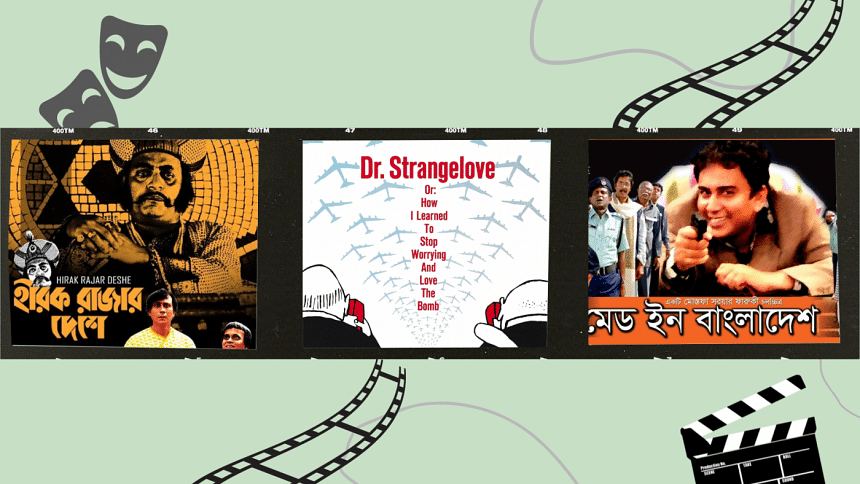Lights, camera, satire

In the world of film, satire and humour have long been utilised as powerful tools for not solely entertaining but also delivering meaningful societal commentary. A well-crafted joke or satirical scene can disarm audiences, prompting them to reflect on societal norms and question their own beliefs. By cloaking serious messages in the veil of humour, filmmakers can effectively challenge the status quo and address pertinent issues without being overtly didactic.
Bengali cinema, with its rich storytelling tradition, has been no stranger to the art of using humour and satire to convey thought-provoking messages while entertaining its audiences. This article aims to explore how the use of humour and satire in movies allows filmmakers across the world to convey thought-provoking messages while entertaining their audiences.
The power of satire
Satire, as an artistic expression, serves as a mirror for society, holding up a distorted reflection of our collective values and behaviours. Through humour, filmmakers can draw attention to the absurdities and hypocrisies that often go unnoticed. Satire becomes a means to unmask the faults and flaws that plague society, encouraging audiences to engage in critical thinking and introspection.

A classic example of using satire to comment on societal norms can be found in Stanley Kubrick's "Dr Strangelove or: How I Learned to Stop Worrying and Love the Bomb", which was released in 1964. The film was originally envisioned as a dramatic look at the Cold War, loosely based on the novel "Red Alert" by Peter George, but Kubrick felt it would be more effective as satire. This British dark comedy parodies the Cold War tensions and the nuclear arms race, using humour to underscore the absurdity of political brinkmanship and the dangers of unchecked power.

The landscape of Bengali cinema is no different when it comes to using satire to critique prevailing social and political issues. Satyajit Ray, a legendary filmmaker in Bengali cinema, used satire effectively in his film "Hirak Rajar Deshe" (The Land of the Diamond King), released in 1980. This sequel to "Goopy Gyne Bagha Byne" (1969) humorously criticised totalitarian regimes and the abuse of power. The heart of the narrative lies within a mesmerising fantasy realm governed by an unrelenting and self-absorbed ruler portrayed brilliantly by Utpal Dutt. Delving deeper, the film artfully unfolds as a thought-provoking political allegory, drawing parallels to the historical period of Emergency under Indira Gandhi's reign. Furthermore, Ray skillfully weaves a broader exploration of totalitarianism, leaving audiences with an insightful reflection on this governing ideology. Through the character of the tyrannical King, Ray provided a sharp commentary on the dangers of unchecked authority and the suppression of dissenting voices.
Using humour to address social issues
Humour has a unique ability to address uncomfortable or sensitive social issues without alienating audiences. Comedy can create a safe space to discuss topics that may otherwise be met with resistance or defensiveness.
The political satire film "Mad_e in Bangladesh", directed by Mostofa Sarwar Farooki, was released in 2007 after being delayed by a year because of opposition from the Bangladesh Film Censor Board over the contents of the film. "Mad_e in Bangladesh" ensembles a stellar cast starring Zahid Hasan, Shahiduzzaman Selim, Tariq Anam Khan, Fazlur Rahman Babu, and Hasan Masood, among others. The story revolves around an apparently passive young man, Khorshed, played brilliantly by Zahid Hasan, who comes to Dhaka from a rural area looking for a job and a better life. Farooki delivered an entertaining drama that is rooted in truth, well-fitted to our socio-political context, and scathing in its criticism of power-politics and the flaws within our system. The film remains as controversial yet as relevant as the year of its release.
Directed by Shiboprosad Mukherjee and Nandita Roy, the Tollywood film "Belaseshe" (2015) humorously delves into the complexities of family dynamics and the changing societal roles of women. Through the character of a middle-aged woman who seeks divorce after decades of marriage, the film challenges societal expectations and highlights the importance of individual agency and happiness.

Another critically acclaimed film, "Four Lions" (2010) by director Chris Morris, employs humour to tackle the delicate subject of terrorism. The film follows a group of inept British jihadists, using dark comedy to highlight the absurdity and futility of their actions while making a broader statement on the root causes of extremism.
Subverting stereotypes through comedy
By playfully subverting established norms, filmmakers can encourage empathy and understanding while celebrating individuality. Bengali cinema has been at the forefront of breaking stereotypes and challenging societal norms through comedy.
"Bhooter Bhabishyat" (2012), directed by Anik Dutta, blends comedy with supernatural elements to deliver a satirical commentary on the urbanisation and gentrification of Kolkata. The movie humorously portrays ghosts from different eras of Kolkata's history, symbolising the lost essence of the city in the face of rapid modernisation.

Humour and satire are potent weapons in a filmmaker's arsenal, enabling them to address serious social issues while keeping audiences engaged and entertained. By skilfully using humour and satire, filmmakers can spark conversations, challenge societal norms, and encourage introspection among viewers. Through the lens of comedy, these movies shed light on the human condition, making us laugh while subtly prodding us to contemplate the state of the world we live in. As we continue to enjoy these films, let us also recognise their deeper messages and the powerful role humour plays in shaping our perception of society.

 For all latest news, follow The Daily Star's Google News channel.
For all latest news, follow The Daily Star's Google News channel. 





Comments